ISSN: 2563-0261
This page will be updated to add the survey results for other pests as they are finalized.
Every year, we conduct surveys to support plant health in Canada.
The Canadian Food Inspection Agency's (CFIA) Plant Health Survey Program supports plant health by detecting new pests and by monitoring the spread of established pest populations, forming the basis for sound regulatory decisions. Surveillance data collected by trapping, visual inspection and sampling efforts contribute to policy development and trade negotiations. Plant health surveillance activities also support Canada in meeting the International Standards for Phytosanitary Measures.
These survey results were collected between April 1, 2024, to March 31, 2025.
Survey results
Forest pests
Emerald ash borer
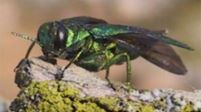
The emerald ash borer (Agrilus planipennis) was first detected in Canada in Windsor, Ontario, in July 2002. Since the initial detection, this species has been found in parts of Ontario, Québec, New Brunswick and Nova Scotia, in Winnipeg (Manitoba), and in Vancouver and Burnaby (British Columbia). The primary goal of this survey is to determine whether emerald ash borer is present in areas where it is not known to occur in order to provide information in support of regulatory decisions.
Method: visual inspection and traps
Two main strategies were used for emerald ash borer detection in Canada:
- visual inspection of ash trees
- trapping using green prism traps baited with attractants
In addition, targeted branch sampling was also used in newly infested areas in British Columbia. This method increases our ability to detect newly infested trees that do not show symptoms or signs of infestation yet.
Target sites for this survey include areas showing broad-scale ash decline and high-risk sites where the pest is most likely to have been introduced through human activities, such as campgrounds, firewood dealers, rest stops along major transportation corridors, urban areas recently planted with host material, sawmills, and holiday destinations. Traps were also deployed within select urban centers using a grid-based approach.
Results from 432 sites surveyed
| Provinces | Number of sites surveyed | Results |
|---|---|---|
| British Columbia | 22 |
Vancouver: Following the 2023 interception of a single adult beetle, follow-up survey activities in 2024 found a total of 19 infested trees (four of them were detected by the city of Vancouver). Eleven were detected by branch sampling and 8 by visual observation. A total of 120 ash trees were branch sampled, which is 1.6% of the total ash population in Vancouver. Burnaby: A single infested ash was found by branch sampling. A total of 95 ash were sampled, which is approximately 10% of the total ash population in Burnaby. |
| Alberta | 57 | No detections |
| Saskatchewan | 10 | No detections |
| Manitoba | 54 | No detections outside the regulated area. |
| Ontario | 96 | Detections in Timiskaming just west of the regulated area of Quebec and in Oliver Paipoonge just outside the Thunder Bay regulated area. |
| Quebec | 26 | Detections in MRCs of Saguenay and Charlevoix. |
| New Brunswick | 40 | No detections |
| Nova Scotia | 99 | Detections in Hants County. |
| Prince Edward Island | 19 | No detections |
| Newfoundland and Labrador | 9 | No detections |
| Canada | 432 | Collaborators surveyed over 470 sites. Regulated areas will be updated to reflect new detections. |
Map of results

The map shows the locations of the 432 surveyed sites for emerald ash borer in 2024, covering all Canadian provinces. The regulated areas for emerald ash borer are shaded with yellow and cover part of New Brunswick, Nova Scotia, Quebec, Ontario, the municipalities of Winnipeg (MB), Vancouver and Burnaby (BC).
There are 417 negative sites shown as green triangles extending the entire area surveyed. Fifteen red triangles indicate positive sites where the beetle was detected outside the regulated areas, in Vancouver and Burnaby (BC), in Oliver Paipoonge and in the district of Timiskaming (ON), in Saguenay and Charlevoix (QC) and in Hants County (NS).
Hemlock woolly adelgid

The Hemlock woolly adelgid (Adelges tsugae) is a destructive pest of susceptible species of hemlock (Tsuga spp.). Native to India, Japan, Taiwan, China and western North America, it was first reported in North America in British Columbia in 1919, and occurs in Alaska, Washington, Oregon, and California. The pest was first detected in the eastern United States in 1951. Since this time, it has steadily spread and is now reported from 21 eastern states. In the eastern U.S., it has resulted in significant mortality of both eastern hemlock, (T. canadensis) and Carolina hemlock, (T. caroliniana) and threatens the existence of these 2 species in many locations. In Canada it has been detected in western Nova Scotia and in southern Ontario.
Method: visual inspection
This survey was conducted between November and June to visually assess hemlock trees for signs and symptoms of attack. Given that the pest is most likely to spread through natural dispersal (wind, water, birds and small mammals) and through infested nursery stock, target sites included nurseries importing hemlock, urban parks and greenspaces, hemlock forest stands within 100 km of the U.S. border and/or infested counties in Canada, and hemlock forest stands along migratory bird routes.
Results from 229 sites surveyed
| Provinces | Number of sites surveyed | Results |
|---|---|---|
| Ontario | 87 | No additional detections |
| Quebec | 29 | No detections |
| New Brunswick | 35 | No detections |
| Nova Scotia | 62 | Detections in Halifax Regional Municipality. |
| Prince Edward Island | 16 | No detections |
| Canada | 229 |
Collaborators surveyed over 130 sites in Ontario, Quebec, Nova Scotia and Prince Edward Island. Regulated areas will be updated to reflect new detections. |
Map of results

The map shows the locations of site that have been surveyed for hemlock woolly adelgid in 2024, covering Eastern Canadian provinces: Ontario, Quebec, Nova Scotia, New Brunswick and Prince Edward Island. The regulated areas for this pest are shaded with yellow and cover part of the Niagara peninsula in Ontario, and the western part of Nova Scotia.
There are 212 negative sites shown as green triangles extending the entire area surveyed. Two red triangles indicate positive sites where the pest was detected outside the Regulated Area in Halifax regional municipality in Nova Scotia. The map also shows 15 red dots indicating the location of detections in previous years in Ontario and Nova Scotia falling outside of the currently established regulated areas.
Oak wilt

Oak wilt (Bretziella fagacearum) is a vascular wilt disease that is capable of killing trees in a single season. It was first recognized as an important forest pest in 1944 in Wisconsin and is now known to occur in 24 states within the U.S. In 2023 oak wilt was detected for the first time in Canada, at three locations in Ontario. An active management plan was implemented to support eradication of the disease at these locations. Oak wilt is spread from diseased to healthy trees through root grafting and by oak bark beetles and sap beetles. All oak species are susceptible to oak wilt, but red oaks are more frequently infected and can die quite quickly. The primary goal of this survey is the early detection of the pest in areas where it is not known to occur.
Method: visual inspection
This survey consists of a visual inspection of host trees for signs and symptoms of oak wilt. Surveys focus on areas where oak wilt could have been introduced through human-assisted movement of infected commodities from infested areas. An emphasis is placed on campgrounds where oak firewood may be transported from infected areas, mills or other facilities importing oak logs, disposal sites and areas where recent weather events may have damaged limbs/trees.
Results from 100 surveyed sites
| Provinces | Number of sites surveyed | Results |
|---|---|---|
| Manitoba | 5 | No detections |
| Ontario | 53 | No additional detections |
| Quebec | 29 | No detections |
| New Brunswick | 5 | No detections |
| Nova Scotia | 8 | No detections |
| Canada | 100 | Oak wilt was not detected in 2024. CFIA assessed more than 100 public reports for oak wilt and followed up with site visits when appropriate. |
Map of results
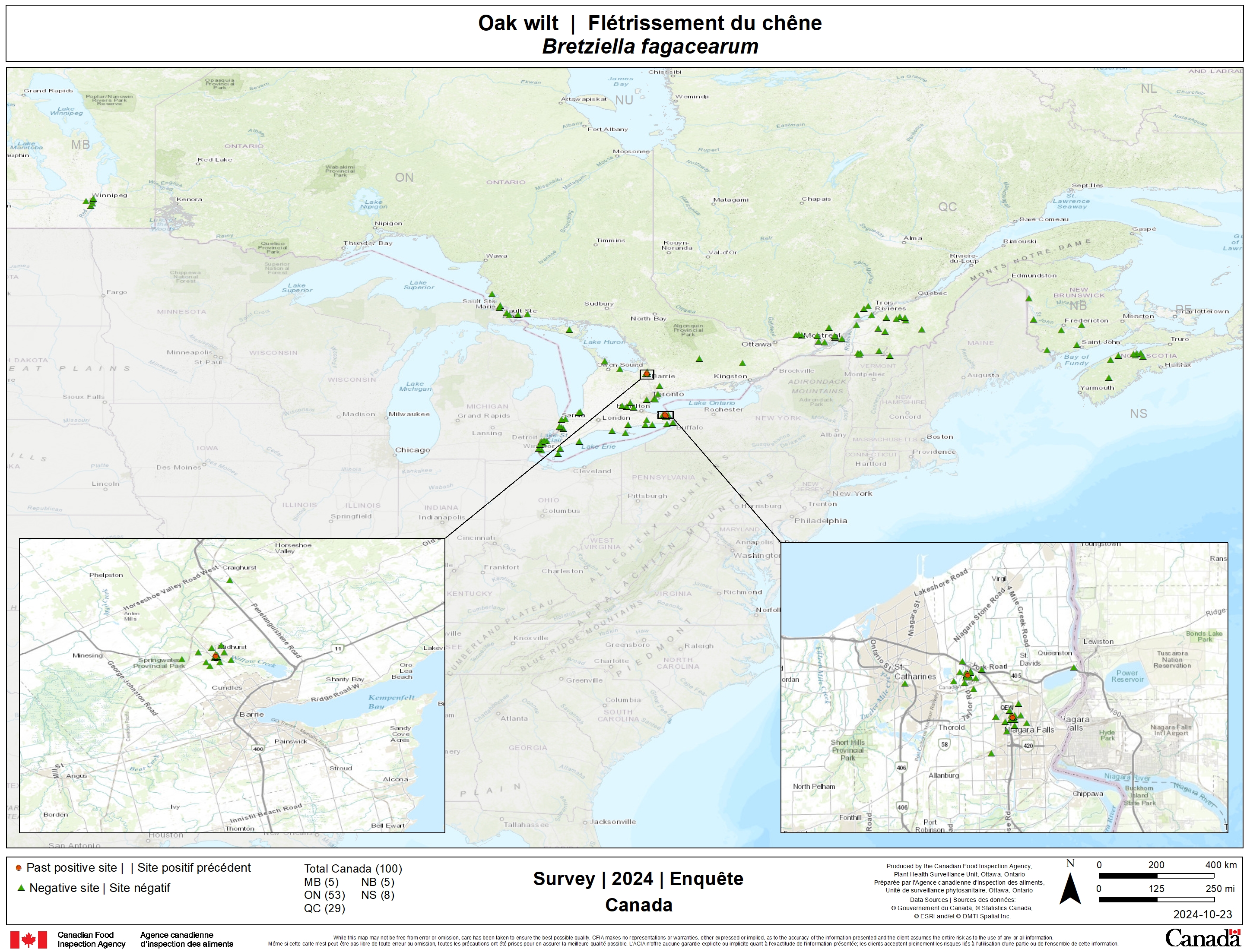
The map shows the locations of sites that have been surveyed for oak wilt in 2024 in the provinces of Manitoba, Ontario, Quebec, New Brunswick and Nova Scotia. On the map, 100 negative sites are shown by green triangles covering the surveyed area. Three red circles show the positive sites from 2023: in the municipalities of Niagara Falls and Niagara-on-the-Lake, and in the township of Springwater.
Brown spruce longhorn beetle

The brown spruce longhorn beetle (Tetropium fuscum) an introduced wood boring pest, is native to north and central Europe and Japan, where it uses stressed and dying conifers as hosts, most notably Norway spruce (Picea abies). All species of spruce in Canada are at risk. In 1999, the beetle was detected in Point Pleasant Park, Halifax, Nova Scotia, and confirmed to have been present since at least 1990. In 2024, it was detected in Quebec, in the Beauce-Sartigan regional county municipality. The brown spruce longhorn beetle is considered to be a pest of quarantine significance in Canada and is regulated under the Plant Protection Act by the CFIA. The entire province of Nova Scotia is regulated for this pest.
Method: traps
Panel traps baited with pheromones are used for this survey. Trapping is conducted at 2 types of sites:
- priority sites such as sawmills, pulpmills, campgrounds and ports
- general forested areas.
This survey is performed in Eastern provinces to prevent further spread from the known infested areas.
Results from 388 sites surveyed
| Provinces | Number of sites surveyed | Results |
|---|---|---|
| Quebec | 113 |
The beetle was detected in the Beauce-Sartigan regional county municipality. Collaborators surveyed an additional 17 sites in Quebec. |
| New Brunswick | 227 | No detections |
| Prince Edward Island | 30 | No detections |
| Newfoundland and Labrador | 18 | No detections |
| Canada | 388 | Additional monitoring in 2025 will continue to inform regulatory decisions and control measures. |
Map of results
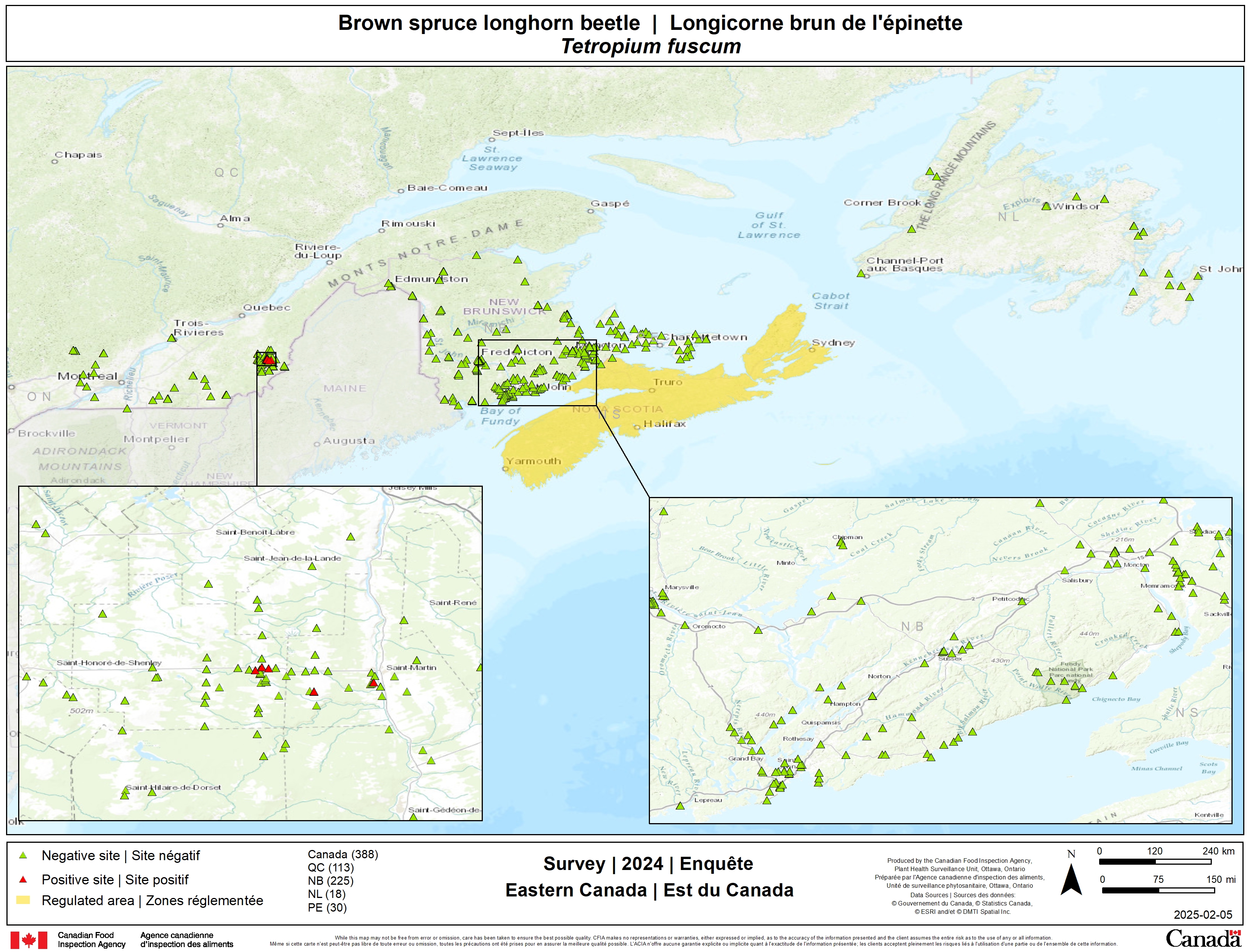
The map shows the locations of sites that have been surveyed for Brown spruce longhorn beetle in 2024, covering the provinces of Quebec, New Brunswick, Newfoundland and Labrador, and Prince Edward Island. The regulated area for this pest is shown in yellow and covers the entire province of Nova Scotia.
There are 383 negative sites shown as green triangles extending the entire area surveyed. Five red triangles indicate positive traps where the beetle was detected in the Beauce-Sartigan regional county municipality, QC.
Spongy moth and flighted spongy moth complex

The spongy moth (Lymantria dispar dispar), formerly known as the European gypsy moth, is established in Ontario, Quebec, New Brunswick, Nova Scotia and in Prince Edward Island. Pheromone-based monitoring surveys are conducted annually in non-regulated areas of Canada. Surveys are also conducted to verify eradication of the insect in areas where eradication programs have been undertaken.
The flighted spongy moth complex (Lymantria dispar asiatica, Lymantria dispar japonica, L. albescens, L. postalba and L. umbrosa) includes related species formerly grouped under the name Asian Gypsy Moth and has been introduced into North America on several occasions, but eradication programs have prevented populations from establishing. This survey is being conducted in support of D-95-03: Plant protection policy for marine vessels arriving in Canada from areas regulated for flighted spongy moth. The flighted spongy moth complex is defined for regulatory purposes as including those subspecies of Lymantria dispar in which the females are capable of sustained directed flight, whereas the spongy moth females are not capable of flight.
Method: traps
Trapping is performed using sticky traps baited with attractants. Two trapping systems can be used depending on the area's status to survey:
- detection trapping is used to determine if European spongy moth is present in an area currently considered free from the pest
- delimitation trapping is used to determine the extent of a population once a detection has been confirmed.
The two systems use different trapping densities. Trapping is focused on areas where the risk of introduction is greatest, for example: ports, container storage yards, intermodal terminals, industrial zones, tourist destinations, campsites and parks, some transportation corridors, etc.
Results from 10,603 sites surveyed
| Provinces | Number of sites surveyed | Results |
|---|---|---|
| British Columbia | 8,020 |
One adult moth of the flight capable flighted spongy moth complex was intercepted in Tsawwassen. Belmont Park (1 moth) |
| Alberta | 871 | Calgary (1) |
| Saskatchewan | 657 | No detections |
| Manitoba | 409 | West Hawk Lake (1) Winnipeg (1) |
| Ontario | 210 | Atikokan (10) Black River-Matheson (145) Cochrane District (48) Dorion (27) Dryden (1) Gurney (17) Ignace (1) Iroquois Falls (20) Kenora (5) Neebing (218) Nipigon (26) Pass Lake (16) Pearl (15) Pigeon River (29) Rainy River District (5) Red Rock (13) Schreiber (19) Terrace Bay (21) Thunder Bay District (1724) White River (4) |
| Quebec | 32 | - |
| New Brunswick | 10 | - |
| Nova Scotia | 5 | - |
| Prince Edward Island | 4 | - |
| Newfoundland and Labrador | 402 | Conception Bay South (30) Elliston (1) Goulds (1) Harbour Grace (2) Grand Falls-Windsor (6) Mount Pearl (1) St. John's (12) |
| Canada | 10,603 |
One adult of the flighted spongy moth complex was found in Tsawwassen, BC. All other traps were negative for this moth, including all traps in other provinces including traps set in Spongy regulated areas of ON, QC, NB, PE, & NS. Collaborators have surveyed close to 900 additional sites for spongy moth. |
Map of results
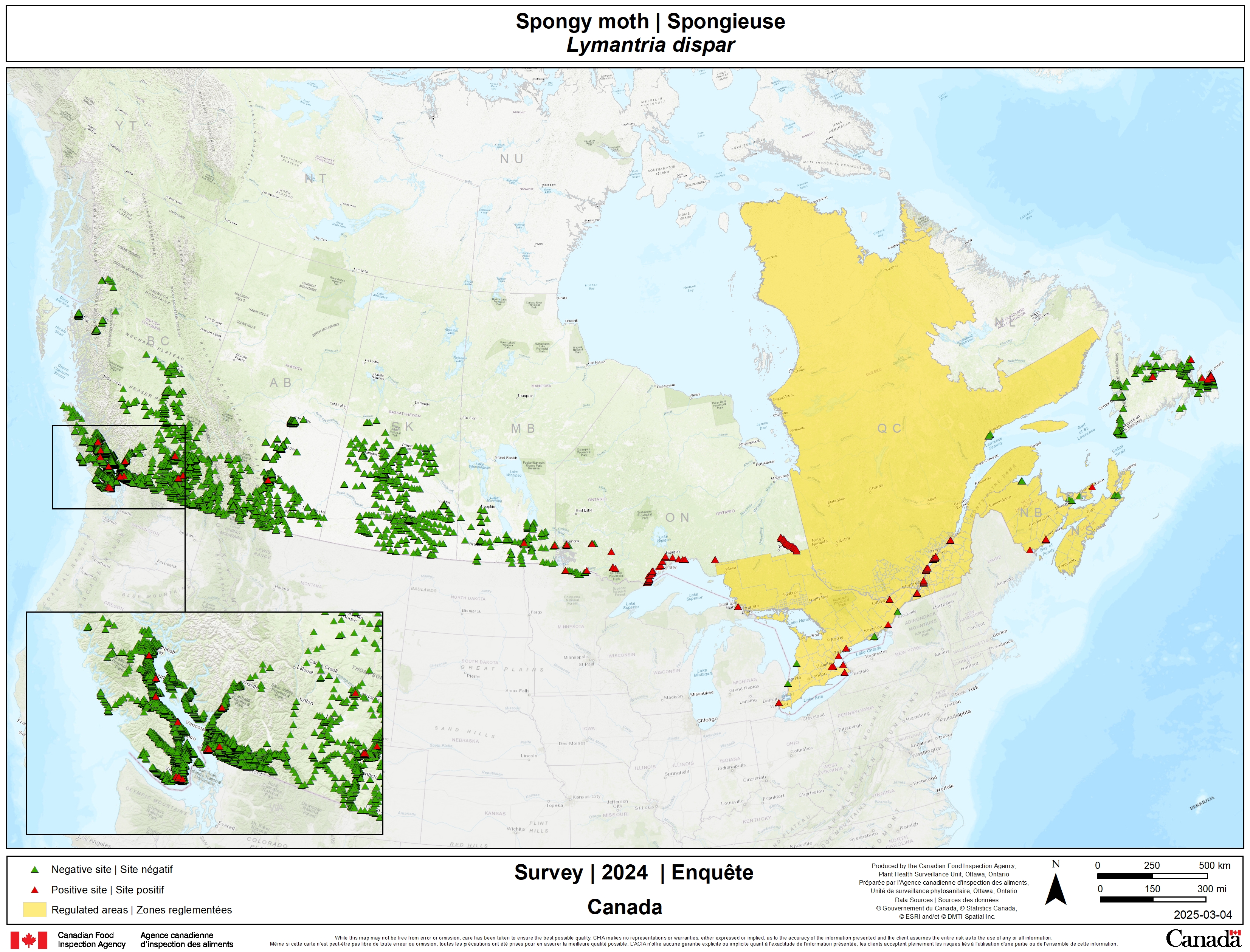
The map shows the locations of sites that have been surveyed for spongy moth in 2024, covering all provinces. The regulated areas for this pest are shaded with yellow and cover the entire provinces of Quebec, New Brunswick, Nova Scotia, Prince Edward Island, and part of the province of Ontario.
There are 10,603 sites shown as green and red triangles extending the entire area surveyed. Red triangles indicate 321 positive sites where the moth was detected. There were detections in all provinces except Saskatchewan and Nova Scotia.
Invasive alien forest insects
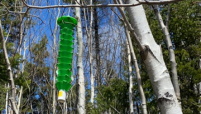
The invasive alien species forest insect survey is a pathway-based survey designed to detect a broad range of wood borers and bark beetles. The survey focusses on forests near urban areas where the risk of invasive alien insect introductions via international wood packaging and dunnage is greatest. The primary goal of this survey is to detect new introductions of non-indigenous species not known to be present in Canada. The invasive alien forest insect survey provides an early warning of the presence of potentially invasive insects in Canada as well as valuable information on the diversity of Canada's insect fauna.
Method: traps
The survey uses semiochemical-baited black (ground level), or green (canopy level) multiple funnel traps. Since 2015, traps have been baited with either the general longhorn lure (fuscumol, fuscumol acetate, ultra-high release ethanol) or the pine sawyer lure (monochamol, ipsenol, ultra-high release alpha-pinene and ultra-high release ethanol).
Results from 68 sites surveyed
| Provinces | Number of sites surveyed | Results |
|---|---|---|
| British Columbia | 7 | No detections |
| Ontario | 21 | No detections |
| Quebec | 21 | No detections |
| New Brunswick | 4 | No detections |
| Nova Scotia | 12 | No detections |
| Newfoundland and Labrador | 3 | No detections |
| Canada | 68 | No new invasive pests were detected. |
Map of results
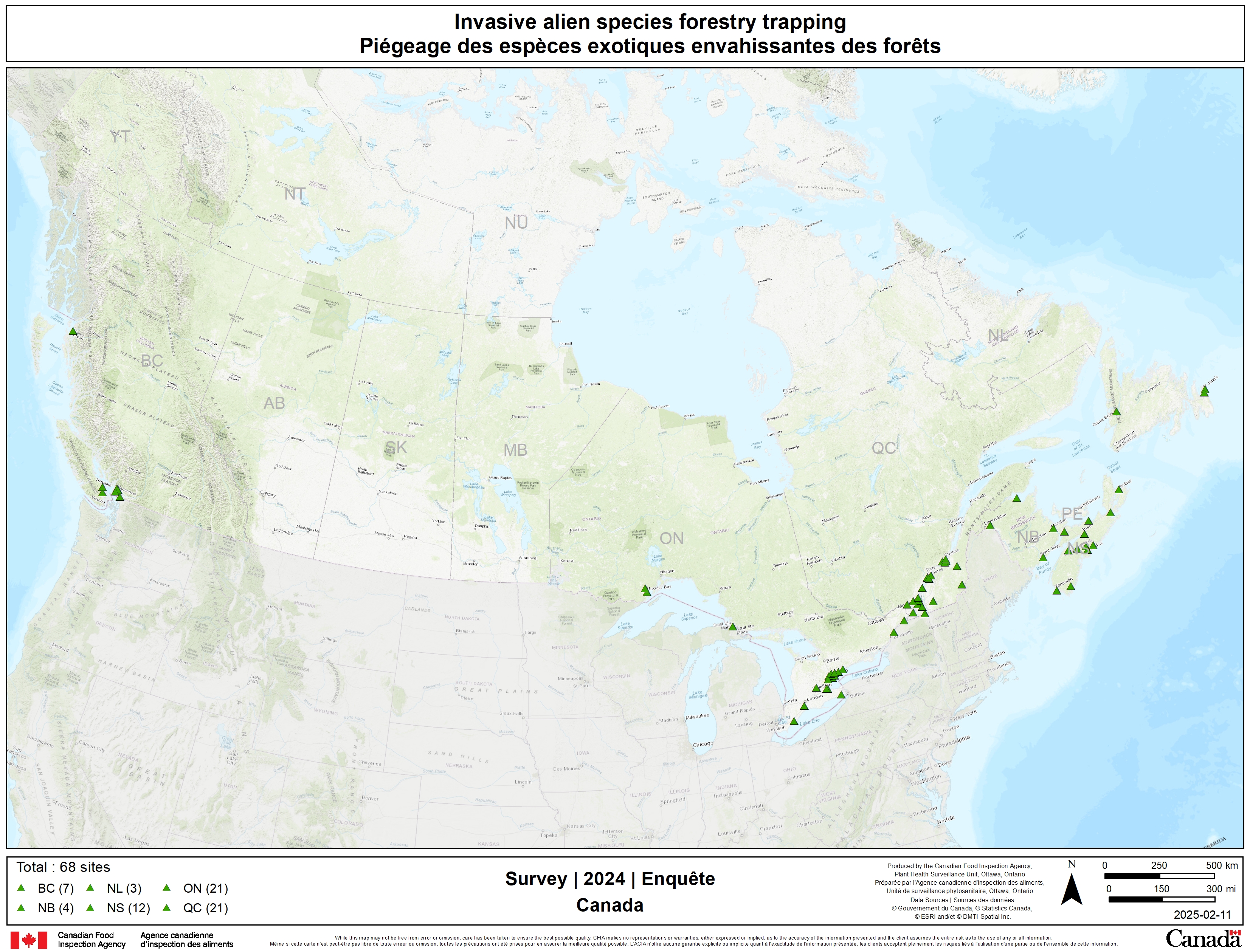
The map shows the locations of sites that have been surveyed for invasive alien forest insects in 2024 in Canada. There are 68 survey sites shown as green triangles and covering the area surveyed in British Columbia, Ontario, Quebec, New Brunswick, Nova Scotia and Newfoundland and Labrador.
Horticulture pests
Ramorum blight
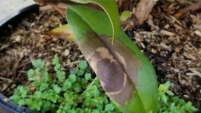
Ramorum blight (Phytophthora ramorum) is a plant pathogen that causes a disease known as ramorum blight on a wide variety of nursery plants. It has also been associated with a disease of oak, known as "Sudden Oak Death", that was first observed in coastal California in the mid-1990's. Since 2003, ramorum blight has been detected in a number of retail/wholesale nurseries in the southern coastal area of British Columbia. The primary goal of this survey is to provide information on the national status of this disease in Canadian nurseries. Additional surveys are also conducted to support eradication activities following a new detection.
Method: visual inspection
The focus of this survey is to visually inspect high-risk host plants at target facilities and to collect samples with symptoms consistent with expression of ramorum blight infection. The survey targets nurseries that propagate the host plants listed in D-01-01: Phytosanitary requirements to prevent the entry and spread of Phytophthora ramorum and nurseries that grow ramorum blight host plants beyond the year of import or propagation, including wholesale nurseries.
Results from 23 surveyed sites
| Provinces | Number of sites surveyed | Results |
|---|---|---|
| British Columbia | 10 | Detection at one nursery, in the district of North Saanich. |
| Ontario | 9 | No detections |
| Quebec | 4 | Interception at one nursery, in the municipality of St-Paul-D'Abbotsford. |
| Canada | 23 | Regulatory measures have been implemented at the infested nurseries and eradication protocols were initiated. |
Japanese beetle

The Japanese beetle (Popillia japonica) has been present in Canada since its first detection in Yarmouth, Nova Scotia, in 1939. This pest affects more than 300 plant species, including many economically important plants such as fruit trees, ornamental shrubs and roses, field crops, turf grasses and sod.
In 2017, Japanese beetle was detected in Vancouver, British Colombia, and a multi-collaborator eradication program has been ongoing since 2018. The trapping efforts in 2018 resulted in the collection of 8,276 beetles. The number of beetles caught went down, following yearly treatments, to 1,157 (2019), 214 (2020) and 79 (2021) before increasing to 201 (2022) and 644 in 2023. In 2024, a total of 574 beetles were caught in British Columbia, including detections in two new municipalities, Kamloops and Abbotsford. However, no beetles were detected in the City of Vancouver in 2024 for the first time since the eradication effort began.
A small population of Japanese beetle were also detected in the City of St. Johns, Newfoundland. Unlike previous years, these beetles were detected in the environment rather than at greenhouses or nurseries.
Method: traps
This survey is conducted using pheromone traps which were installed in May and remained in the field until October. The traps contain a Japanese beetle attractant which is a combination of a floral lure and a pheromone. In the greater Vancouver area, where eradication is in progress, traps are deployed at various densities, with infested municipalities having the highest density of traps. For other locations in Canada, traps are placed adjacent to, or near importers of sod, soil or nursery stock from Japanese beetle infested areas and include sites such as nurseries, sod farms, golf courses, cemeteries, public parks and gardens, food terminals, truck and rail compounds/terminals, airports and border points.
Results from 4,625 sites surveyed
| Provinces | Number of sites surveyed | Results |
|---|---|---|
| British Columbia | 4,523 |
Vancouver: no detections for the first time since eradication efforts began. Burnaby: 19 beetles were caught in 3 traps. Port Coquitlam: 541 beetles were caught in 46 traps. The pest was also detected in two new municipalities: Abbotsford (1 beetle in 1 trap) and Kamloops (11 beetles in 4 traps). |
| Alberta | 10 | No detections |
| Newfoundland and Labrador | 92 |
St John's: 13 beetles were captured at 7 sites. Bay Bulls: 1 beetle captured at 1 site. |
| Canada | 4,625 | We continue to support our collaborators in their effort to eradicate the pest. Trapping efforts will continue in the greater Vancouver area and around new satellite infestations in the province of British Columbia. |
Map of results
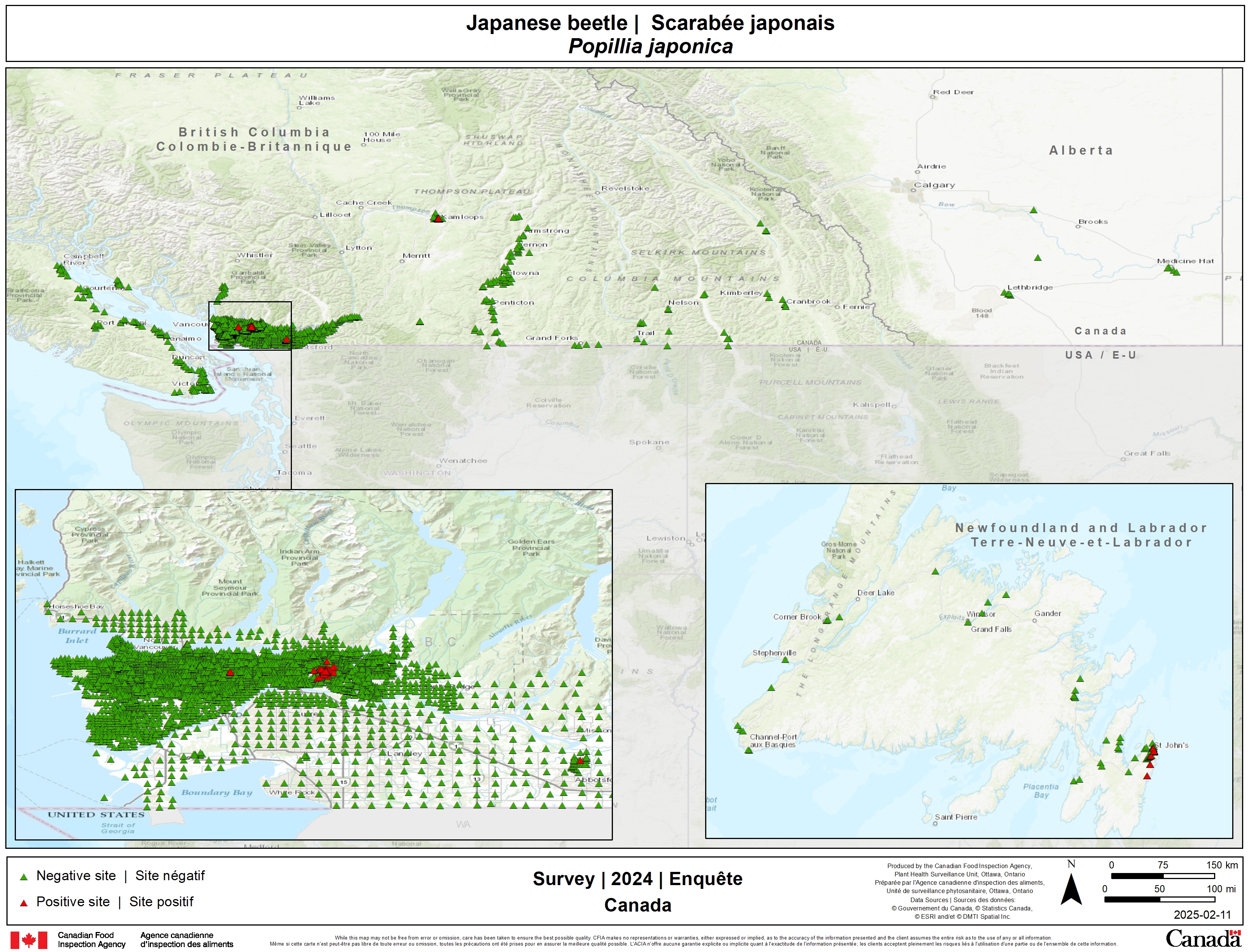
The map shows the locations of sites that have been surveyed for Japanese beetle in British Columbia, Alberta and Newfoundland and Labrador in 2024.
There are 4,563 negative sites shown as green triangles extending the entire area surveyed. On the map, 62 red triangles indicate positive sites where the pest was detected in Burnaby, Port Coquitlam, Abbotsford and Kamloops in British Columbia, and in St John's and Bay Bulls in Newfoundland and Labrador.
Plum pox virus

Plum pox virus (Potyvirus plumpoxi) is a serious plant disease that affects many stone fruit species within the genus Prunus, including peaches, nectarines, plums, apricots, almonds and some ornamental varieties. Although it does not kill trees, it reduces the marketability of the fruit, causes early fruit drop in infected trees and drastically reduces fruit yields. Plum pox virus is present in the Niagara area. This survey is being conducted in support of policies and programs related to D-99-07: Policy for importation from the United States and domestic movement of plum pox virus susceptible prunus propagative plant material.
Method: leaf sampling
Leaf sampling surveys take place at select orchard and residential properties to ensure continued monitoring along the boundary of the plum pox virus regulated area. In addition, propagation inspections are completed at select orchards and residential properties to verify compliance with the Prunus propagation ban. Depending on the location and site type, these activities are performed on a rotational basis, taking place every one to three years.
Results from 185 sites surveyed
| Provinces | Number of sites surveyed | Results |
|---|---|---|
| Ontario | 185 |
44 orchards and 141 residential properties were visited and sampled. As a result of the detection of plum pox virus along the periphery of the regulated area in 2024, the western boundary of the PPV regulated area was expanded in February 2025. |
Blueberry maggot
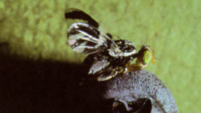
The blueberry maggot (Rhagoletis mendax) is an indigenous pest of commercially grown lowbush and highbush blueberries in the Canadian Maritime Provinces. It is currently found in Nova Scotia, New Brunswick, Prince Edward Island and parts of Ontario and Quebec. It is not found in Newfoundland & Labrador or in western Canada.
Method: traps
This survey is conducted with the use of baited traps which are attractive to male and female blueberry maggot adult flies. Multiple traps are placed within blueberry plantations and wild sites containing host species in areas not regulated for blueberry maggot. Traps are installed prior to the pest's flight period in late June and collected at the end of harvest or fruit drop, in late August or early September.
Results from 70 sites surveyed
| Provinces | Number of sites surveyed | Results |
|---|---|---|
| British Columbia | 23 | No detections |
| Ontario | 16 | No new detections outside the known infested areas. |
| Quebec | 6 | No new detections outside the known infested areas. |
| Newfoundland and Labrador | 25 | No detections |
| Canada | 70 | Regulated areas remain unchanged. |
Map of results
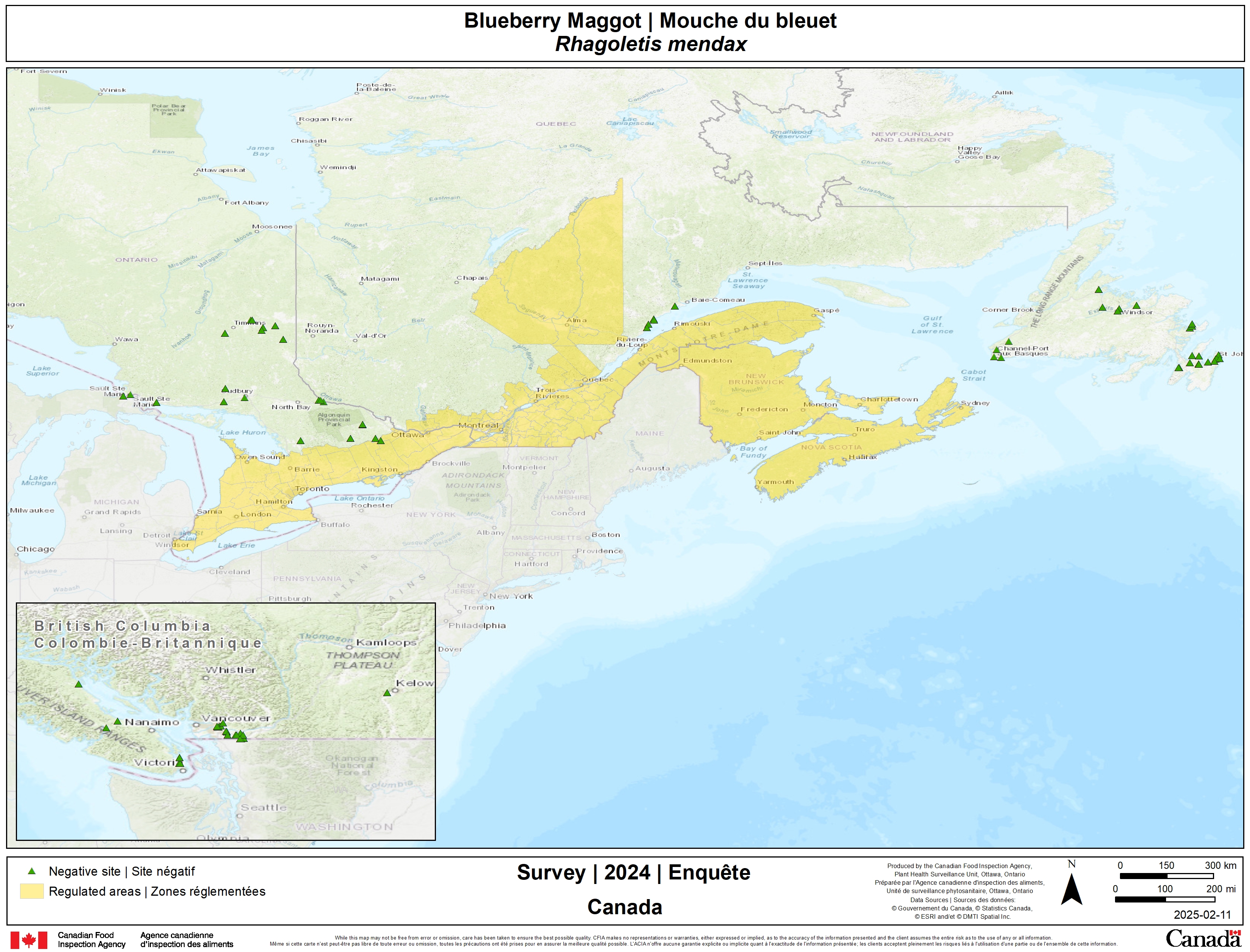
The map shows the locations that have been surveyed for blueberry maggot in Canada in 2024, in the provinces of British Columbia, Ontario, Quebec and Newfoundland and Labrador. The regulated areas for the blueberry maggot are shaded in yellow and cover the entire provinces of New Brunswick, Nova Scotia and Prince Edward Island, and parts of Ontario and Quebec.
There are 70 negative sites shown as green triangles extending the entire area surveyed.
Apple maggot
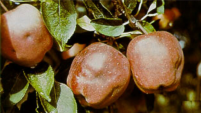
Apple maggot (Rhagoletis pomonella) is an indigenous pest of apples in Canada. The BC Interior is the last major apple growing area of North America free from this pest. The objective of this survey is the early detection of apple maggot to maintain the pest-free area of the BC Interior. This survey is being conducted in support of policies and programs related to CFIA policy directive D-00-07: Phytosanitary requirements to prevent the introduction and spread of apple maggot. In 2015, a single female apple maggot was detected in West Kelowna and in 2016 another single female was detected in the city of Kelowna. Despite increased surveillance from 2016 to 2019 apple maggot has not been detected since 2016.
Method: traps
This survey is conducted using sticky red spheres baited with an attractant and placed in host plants between June and September, when adult apple maggot flies are active. Traps are deployed to give an optimal coverage of known pome fruit production areas and associated urban and rural properties with suitable hosts, as well as riparian areas. The survey also includes selected sites that are perceived to be high risk for introduction of the pest.
Results from 433 surveyed sites
| Provinces | Number of sites surveyed | Results |
|---|---|---|
| British Columbia | 433 |
No new detections in the pest free area and outside the known infested areas. The pest free area in the interior of British Columbia is considered free from apple maggot. |
Map of results
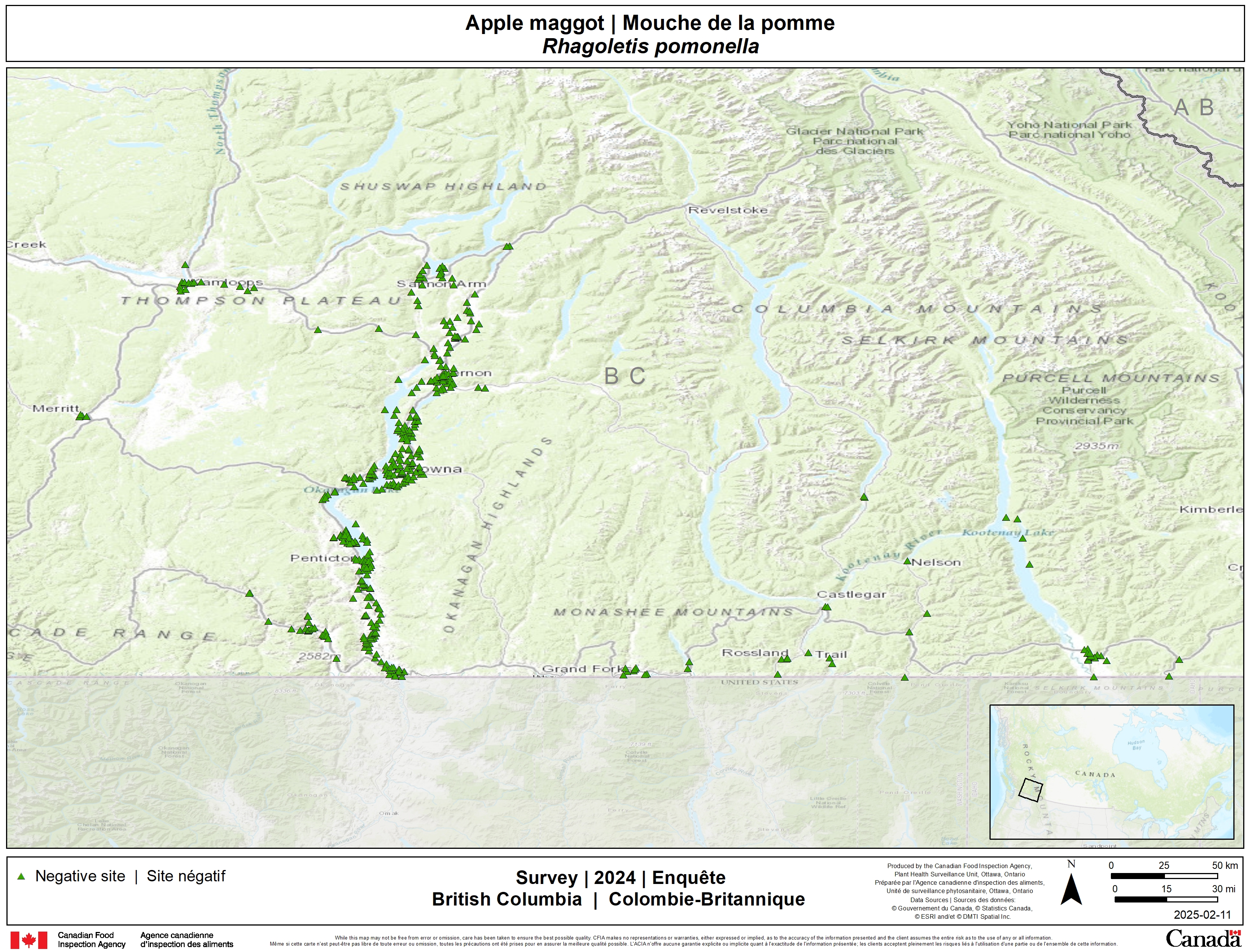
The map shows the locations of sites that have been surveyed for apple maggot in British Columbia, Canada, in 2024. There are 433 negative sites shown as green triangles extending the entire area surveyed.
Tobacco blue mold
Tobacco blue mold (Peronospora hyoscyami f.sp. tabacina) is a serious disease of solanaceous plants including tobacco, peppers, tomato and eggplant. It was reported for the first time in North America in 1921, in the States of Florida and Georgia. In Canada it was first reported in Ontario in 1938. This disease has never been reported from British Columbia. Survey activities for this pest are conducted to confirm British Columbia's pest-free status for the exportation of peppers.
Method: visual inspection
This survey was conducted in cooperation with Agriculture and Agri-Food Canada. Visual surveys were conducted on indicator plants (Tobacco blue mold-sensitive tobacco plants, Nicotiana tabacum) at three sites in southwestern British Columbia.
Results from 3 surveyed sites
| Provinces | Number of sites surveyed | Results |
|---|---|---|
| British Columbia | 3 |
No detections There are no changes to the status of tobacco blue mold in Canada. |
Oriental fruit moth
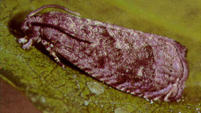
The oriental fruit moth is native to China and Korea. It was first detected in Ontario in 1925. The oriental fruit moth likely spreads to other countries in cocoons on dormant trees or in infested fruit. The principal host is Prunus (peach, nectarine, apricot, plum, cherry). In Ontario, apple (Malus) and pear (Pyrus) can also be infested when they are grown in proximity to peach orchards. The pest was intercepted in British Columbia in 2019 and again in 2022. In both cases a single moth was caught. Follow-up surveillance did not detect any evidence of establishment of this pest in British Columbia. This survey is done to maintain the pest-free status of British Columbia.
Method: visual inspection and traps
Two main strategies were used for oriental fruit moth detection in Canada:
- visual inspection of host plants
- traps baited with pheromones and placed on host plants
Surveys are conducted in orchards, hobby farms, ornamental nurseries and wholesale fruit handlers where target hosts are present. Adult oriental fruit moths were surveyed using pheromone-baited traps placed on target hosts by June 15th and removed by September 20th, or the first frost, whichever date was earliest. Target hosts were also visually inspected for visible signs of damage and for presence of larvae or pupae.
Results from 257 surveyed sites
| Provinces | Number of sites surveyed | Results |
|---|---|---|
| British Columbia | 257 |
No detections British Columbia is considered free from oriental fruit moth. |
Potato pests
Potato wart

Potato wart disease, also known as potato canker, is caused by Synchytrium endobioticum, a soil-borne fungus. Potato (Solanum tuberosum) is the only cultivated host. The fungus attacks the growing points on the potato plant, such as eyes, buds and stolon tips. The fungus can remain dormant in the soil for more than 40 years as resting spores. In Canada, potato wart is present in Prince Edward Island (PEI) and in Newfoundland and Labrador. The purpose of this survey is to monitor for the presence of Synchytrium endobioticum outside of Newfoundland and Labrador and restricted fields in PEI. This survey is in addition to any sampling and analysis associated with potato wart restricted fields in PEI.
Method: visual inspection and soil sampling
Two main strategies were used for potato wart detection in Canada:
- visual inspection of tubers
- soil sampling and analysis
Suspect tubers and soil samples are sent to a CFIA laboratory for analysis. The survey is conducted by sampling soil from seed potato fields in areas where potato wart is not known to occur. Soil is collected using a regular grid pattern, known as grid soil sampling, or collected from underneath equipment as it falls from tubers as potatoes move into storage, known as tare soil sampling. Each soil sample collected represents approximately 1 acre of potato production.
Results from 2,240 samples collected
| Provinces | Number of sites surveyed | Results |
|---|---|---|
| British Columbia | 17 | No detection. Collected from seed production fields using grid soil sampling. |
| Alberta | 202 | No detection. Collected from seed production fields using grid soil sampling. |
| Saskatchewan | 47 | No detection. Collected from seed production fields using grid soil sampling. |
| Manitoba | 141 | No detection. Collected from seed production fields using grid soil sampling. |
| Ontario | 229 | No detection. Collected from seed production fields using grid soil sampling. |
| Quebec | 142 | No detection. Collected from seed production fields using grid soil sampling. |
| New Brunswick | 529 | No detection. Collected from seed production fields using grid soil sampling. |
| Nova Scotia | 36 | No detection. Collected from seed production fields using grid soil sampling. |
| Prince Edward Island | 883 | No detection. Collected from unrestricted fields with all types of potato production using tare soil sampling. |
| Newfoundland and Labrador | 14 | No detection. Collected from seed production fields using grid soil sampling. |
| Canada | 2,240 | There are no changes to the status of this pest in Canada. |
Potato cyst nematode
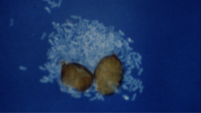
Golden nematode and pale cyst nematode are two species of potato cyst nematode that are quarantine pests in Canada. If left unmanaged, they can reduce yields of potatoes and other host crops such as tomatoes and eggplants by up to 80 percent. These pests infest the soil and are very difficult to eradicate because they can persist, dormant in the soil, for several decades. They do not pose a risk to human health. Both of these quarantine potato cyst nematodes have been confirmed in 65 countries worldwide, including the United States and Canada.
Method: soil sampling
Soil sampling is conducted each year across Canada for either regulatory purposes or to certify seed potato shipments for export. A regular grid pattern is used to collect soil samples from the fields. Each soil sample collected represents approximately 1 acre of potato production.
Results from 12,267 samples collected
| Provinces | Number of sites surveyed | Results |
|---|---|---|
| British Columbia | 68 | No detection. Samples were collected for the certification of seed potato shipments. |
| Alberta | 6,647 | No detection. Samples were collected for the certification of seed potato shipments. |
| Saskatchewan | 2,625 | No detection. Samples were collected for the certification of seed potato shipments. |
| Manitoba | 735 | No detection. Samples were collected for the certification of seed potato shipments. |
| Ontario | 150 | No detection. Samples were collected for the certification of seed potato shipments. |
| Quebec | 320 | No detection. Samples were collected for the certification of seed potato shipments. |
| New Brunswick | 1,477 | No detection. Samples were collected for the certification of seed potato shipments. |
| Nova Scotia | 41 | No detection. Samples were collected for the certification of seed potato shipments. |
| Prince Edward Island | 190 | No detection. Samples were collected for the certification of seed potato shipments. |
| Newfoundland and Labrador | 14 | No detection. Samples were collected for the certification of seed potato shipments. |
| Canada | 12,267 | There are no changes to the status of this pest in Canada. |
Contact us
For any questions regarding CFIA's plant protection surveys, contact cfia.surveillance-surveillance.acia@inspection.gc.ca.